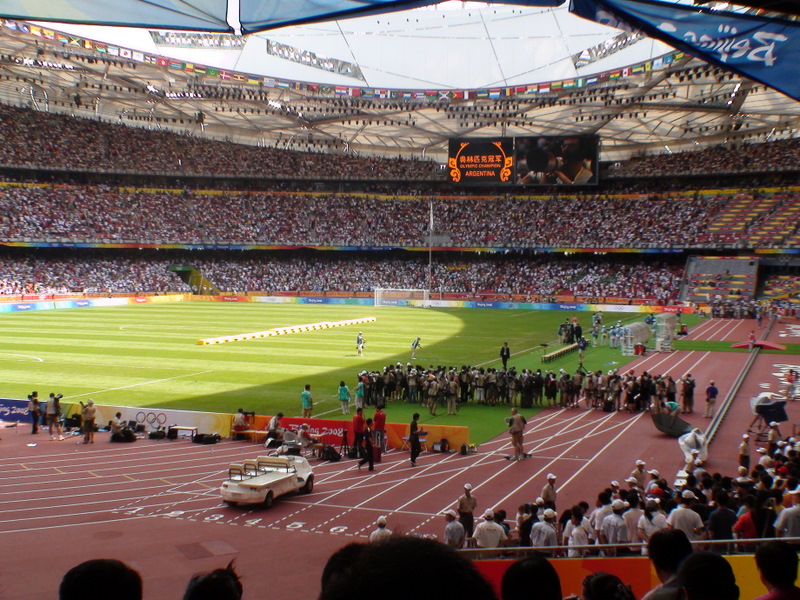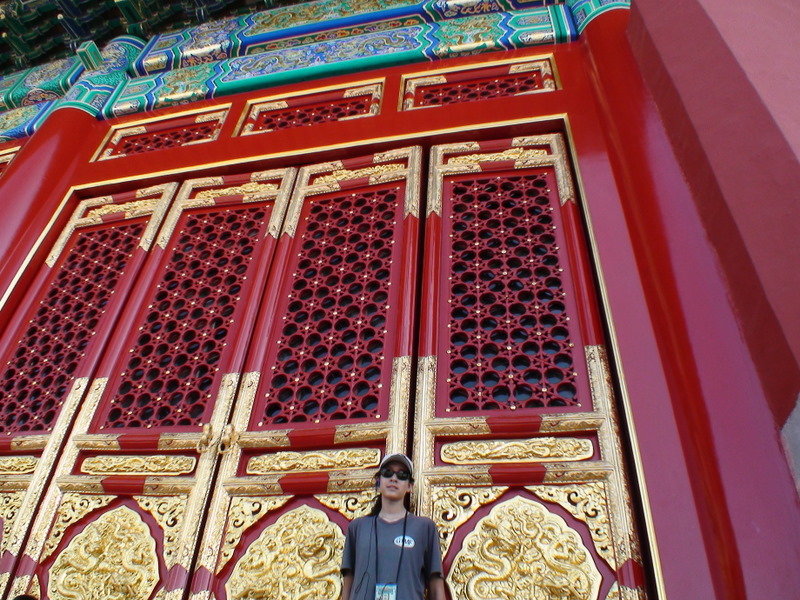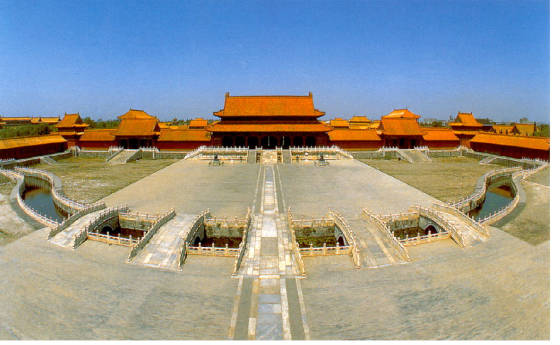|
ARRIVAL IN BEIJING, CHINA
By
Kambiz Taleghani
20080819-26  Finally arrived in Beijing on an overnight flight from Istanbul. We had originally planned to drive from Europe to Beijing
and actually began our drive from Netherlands. However, due to Chinese last-minute closing of their land borders to foreigners
driving their cars, we had to turn back at Caspian Sea. After many days of planning and re-planning on a driving trip that
took us through 10 countries in Europe and Asia, we drove back as far as Istanbul, Turkey, where we finally found shipping
and sent our car back to Los Angeles. Then flew to China. Finally arrived in Beijing on an overnight flight from Istanbul. We had originally planned to drive from Europe to Beijing
and actually began our drive from Netherlands. However, due to Chinese last-minute closing of their land borders to foreigners
driving their cars, we had to turn back at Caspian Sea. After many days of planning and re-planning on a driving trip that
took us through 10 countries in Europe and Asia, we drove back as far as Istanbul, Turkey, where we finally found shipping
and sent our car back to Los Angeles. Then flew to China.
. 
Joy, our hostess/landlord, was waiting for us at the airport. After our long overnight
flight, we were tired and giddish at the same time. The new Beijing Airport terminal was very nice. So organized. China had truly rolled-out the welcome, and we felt it. Uniformed personnel where everywhere to be seen. A very interesting tradition, to us, is that the Chinese in uniform
had to stand at attention when stationary. When moving, they moved in lines even when there were only two of them. I could
not help but notice a janitorial crew. Even they were slow-marching in a line! Took a funny picture with two uniformed people
at the arrivals. (picture, below!). 
. Our Welcoming Party at Beijing Airport! (Actually, that
was very nice of them to allow us take this funny picture! They were not allowed to move or respond. Had to remain
at attention all the time) . . . . .  
The air was much cleaner than we had anticipated. Apparently
many factories upwind of Beijing had been ordered closed prior to the Olympics in an attempt to improve the air quality. It
must have worked, for the air pollution was not noticeable. Blue skies! Drove to Olympic office and picked our pre-purchased tickets. That day was weight-lifting, which we missed by a few
hours. We had purchased tickets almost one year in advance. Due to scarcity of tickets, we had purchased whatever we could
get our hands on. None of the events that we wanted to see had tickets available, even one year in advance! (tennis, gymnastics,
diving, volleyball, etc. were all sold-out last year). However, by chance, Leila found tickets for football/soccer finals
on the internet last year (fall 2007) and we had grabbed them. The black-market price for the closing ceremonies was $5900USD
per ticket. Forget that one!  Driving was so calm and quiet after our recent exposure to Turkey, Iran, Azerbaijan, Georgia, and Eastern Europe! All cars
actually obeyed the traffic signals and stayed in their lanes! No fighting or yelling among drivers (Can you imagine?!!!).
No constant blowing of horns. Speed limits were actually honoured! How "unusual" and pleasant! A cultural shock
for us after 60 days of driving in chaos! Driving was so calm and quiet after our recent exposure to Turkey, Iran, Azerbaijan, Georgia, and Eastern Europe! All cars
actually obeyed the traffic signals and stayed in their lanes! No fighting or yelling among drivers (Can you imagine?!!!).
No constant blowing of horns. Speed limits were actually honoured! How "unusual" and pleasant! A cultural shock
for us after 60 days of driving in chaos!
(Note the Chinese version of Buick
from GM. Pictrure, right) Joy, our landlord/hostess,
had a brand new luxury Honda minivan ($40K USD). Since prosperity has reached Chinese middle-class during the past 10 years,
all vehicles seemed new. Very rare to see an "old' car in China because, until recently, they simply had no cars
so to age.  We had rented a townhouse in a gated community south of Beijing. In China there is no private land, but you can own the building
on the land! Unusual for most of us. The owner leases the land from the government on a 50-year basis. No one knows what will
happen after 50-year term is up! Theoretically, your house will revert back to the government! Very nice, modern, and well-maintained
3-story house. In the basement there was an entertainment center, games, bar, and ping pong table. Our hosts were a very nice
and enterprising family who owned multiple properties and rented them out. This was their own residence as well. They occupied
the third floor. We had the second floor which had the bedroom suites. The ground floor had the kitchen, dining, living, and
reception area. Wide screen TV in every room. We had rented a townhouse in a gated community south of Beijing. In China there is no private land, but you can own the building
on the land! Unusual for most of us. The owner leases the land from the government on a 50-year basis. No one knows what will
happen after 50-year term is up! Theoretically, your house will revert back to the government! Very nice, modern, and well-maintained
3-story house. In the basement there was an entertainment center, games, bar, and ping pong table. Our hosts were a very nice
and enterprising family who owned multiple properties and rented them out. This was their own residence as well. They occupied
the third floor. We had the second floor which had the bedroom suites. The ground floor had the kitchen, dining, living, and
reception area. Wide screen TV in every room.
 Joy's husband, Michael, was, among many other things, a master chef. He prepared a Chinese meal when we arrived in the
evening. A sumptuous treat. After this dinner it was impossible to appreciate any restaurant meal! Joy's husband, Michael, was, among many other things, a master chef. He prepared a Chinese meal when we arrived in the
evening. A sumptuous treat. After this dinner it was impossible to appreciate any restaurant meal!
Daniel, the couple's son was two years younger than Leila. Joy was fluent in English. Her husband and son were
not. We had to put our limited Chinese to test. Leila and I had taken occasional Chinese lessons for a few years prior to
arrival here, but it was a real struggle. Somehow, nothing came to mind when we really needed the vocabulary! We struggled
and laughed trying to communicate. Somehow it worked, sort of!  China has a one-child policy in an attempt to control its once-out-of-control population growth. You must pay a very high
fee if you want to have a second child (in the order of many thousands of dollars equivalent). Almost no one can "afford"
to have a second child. As a result parents dedicate all their rearing time, efforts, and resources to raising one child.
There is a wave of highly educated and well brought-up children who will soon take over the country. What a bright future
for that nation. China has a one-child policy in an attempt to control its once-out-of-control population growth. You must pay a very high
fee if you want to have a second child (in the order of many thousands of dollars equivalent). Almost no one can "afford"
to have a second child. As a result parents dedicate all their rearing time, efforts, and resources to raising one child.
There is a wave of highly educated and well brought-up children who will soon take over the country. What a bright future
for that nation.
To reduce traffic, Beijing had adopted odd-even
days. Depending on what number plate you had, you could either drive on odd or even days. We were in luck: Joy had two cars,
one with odd and the other with even-numbered plates! Taxis
were plentiful, reasonably-priced, and clean. To get around we also used Beijing's meticulously-clean subway with new
cars. All cars had flat-screen with bi-lingual visual and audio announcements in Mandarin and English. Unlike many countries,
the recorded English was impeccable. For those with Olympic tickets, subway was free!  
I found the above picture a touching scene. It was raining lightly.
The man, in his 70's, stopped briefly to cover his mother, in her 80's or 90's, sitting on the back of the tricycle
with the umbrella in her hand. He took about 2-3 minutes to make sure she was comfortable and well covered, then peddled
off. He was very wet himself. Very touching scene, it was. . You can still observe a few motorized rickshaws in Beijing. Here is one on the left. . 
. (picture, right).
This is a well-known noodle restaurant in Beijing. Very large place. Very loud. Very
busy at all time. Delicious food. I wish I could remember the name.
It is diagaonally across the "Pearl Centre". Later,
we bought all of Leila's school supplies from a multi-story building across the street from this restaurant with many,
many individual open stores. For us, amazingly
low prices. We must have over-purchased one-year's supply of school items for 10% of what it would have cost
in the U.S. Very interesting. . One experience we enjoyed and found interesting was shopping for groceries and
everyday needs in supermarkets and general markets. Most items seemed unusual to us. Lots of prepared foods. I remember once
seeing a dragon fruit on sale in California - for $24 each! In China, about 10 Cents each! Many varieties of cooked and prepared
eggs: Chick, duck, pigeon, etc. Breakfast cereals looked the same! Very
simple and effective attempt at conservation and recycling. No free shopping bags. You must purchase your plastic supermarket
bags at a very inflated price. (something like 50Cents each). The message: "Better use your own. In other words, ... what an extremely pleasant experience.
5 DAYS of OLYMPICS Our days in Beijing were divided into attending one Olympic game per day and visiting tourist attractions the remainder
of the time.  
 
We attended, two handball games, athletics, and football/soccer final
between Nigeria and Italy.
       
SIGHTSEEING AROUND BEIJING By Kambiz Taleghani
20080819-26 We visited the City of Beijing, Great Wall, Ming tombs, Tiananmen Square, the Forbidden
City, Summer palace, Pearl Center, a Cloisonet Factory, and Beijing International School which is an English language school
from Elementary through high school. BEIJING, THE CITY
TIANANMEN
SQUARE  Tiananmen Square is the large plaza near the center of Beijing, named after the Gate of Heavenly Peace which sits to its north.
Tiananmen is the southern approach to the Forbidden City. It has great cultural significance as a symbol because it was the
site of several key events in Chinese history. Chairman Mao's mausoleum sits on Tiananmen. Tiananmen Square is the large plaza near the center of Beijing, named after the Gate of Heavenly Peace which sits to its north.
Tiananmen is the southern approach to the Forbidden City. It has great cultural significance as a symbol because it was the
site of several key events in Chinese history. Chairman Mao's mausoleum sits on Tiananmen.
The square itself is 100
acres! (41 hectares) which makes it the largest open urban square in the world.
The Square, however, was not officially
made until the PRC took power in 1949.
Near the centre of today's square, close to the site of the Mao Zedong's
Mausoleum, once stood one of the most important gates of Beijing. This gate was known as the "Great Ming Gate".
 The remains of Mao, the Great Helmsman, as he is sometimes known, are on display for public viewing. People line up for hundreds
of feet every day to see the former chairman, many paying tribute to him with flowers that can be rented at the entrance on
the north side. There is a souvenir shop at the exit on the south side. The remains of Mao, the Great Helmsman, as he is sometimes known, are on display for public viewing. People line up for hundreds
of feet every day to see the former chairman, many paying tribute to him with flowers that can be rented at the entrance on
the north side. There is a souvenir shop at the exit on the south side.
It was hot and humid on the day we visited. Also,
in conjunction with Olympics there was extra landscaping and Olympic monuments erected on the square. With picture-taking
and what not, it took us over an hour go cross the square!
.
FORBIDDEN CITY
 We visited the Forbidden City on a hot August afternoon. Very crowded. We obtained self-guided headphones whose pre-recorded
messages are triggered by your location within the palace. Very interesting. They have them in many languages of the world.
We took English, French, and Persian. It was fund to switch them and listen to different descriptions of the same subject. We visited the Forbidden City on a hot August afternoon. Very crowded. We obtained self-guided headphones whose pre-recorded
messages are triggered by your location within the palace. Very interesting. They have them in many languages of the world.
We took English, French, and Persian. It was fund to switch them and listen to different descriptions of the same subject.
 The Forbidden City, called Gu Gong in Chinese, was the Chinese imperial palace from the mid-Ming Dynasty, which began in began
in 1368, and lasted until 1644 a.d., to the end of the Qing Dynasty. Qing were Manchu who ruled China from 1644 until 1911.
It is located in the middle of Beijing. The Forbidden City, called Gu Gong in Chinese, was the Chinese imperial palace from the mid-Ming Dynasty, which began in began
in 1368, and lasted until 1644 a.d., to the end of the Qing Dynasty. Qing were Manchu who ruled China from 1644 until 1911.
It is located in the middle of Beijing.
It is the world's
largest palace complex and covers 74 hectares (150 acres). Surrounded by a six metre (18 feet) deep moat and a ten meter (30
feet) high wall are 9,999 rooms. The wall has a gate on each side. The distance between these two gates is 960 meters (3000
feet). The Forbidden City is divided into two parts. The southern section, or the Outer Court was where the emperor exercised
his supreme power over the nation. The northern section, or the Inner Court was where he lived with his royal family. Until
1924 when the last emperor of China was driven from the Inner Court, fourteen emperors of the Ming dynasty and ten emperors
of the Qing dynasty had reigned here. Having been the imperial palace for some five centuries, it houses numerous rare treasures
and curiosities. Listed by UNESCO as a World Cultural Heritage Site in 1987, the Palace Museum is now one of the most popular
tourist attractions world-wide.  Construction
of the palace complex began in 1407, the 5th year of the Yongle reign of the third emperor of the Ming dynasty. It was completed
fourteen years later in 1420. There were ships sent all around the world (of that era) who brought back kings, princes, and
dignitaries from all around the world for the opening ceremonies of the Forbidden City. It was said that a million workers including one hundred thousand artisans were driven into the long-term hard labor.
It was said a well was dug every fifty meters (150 feet) along the road in order to pour water onto the road in winter to
slide huge stones on ice into the city. Huge amounts of timber and other materials were freighted from faraway provinces.
Ancient Chinese people displayed their very considerable skills in building the Forbidden City. Take the grand red city wall
for example. It has an 8.6 meters wide base reducing to 6.66 meters wide at the top. The angular shape of the wall totally
frustrates attempts to climb it. The bricks were made from white lime and glutinous rice while the cement is made from glutinous
rice and egg whites. These incredible materials make the wall extraordinarily strong.
Since yellow is the symbol of the royal family, it is the dominant color in the
Forbidden City. Roofs are built with yellow glazed tiles; decorations in the palace are painted yellow; even the bricks on
the ground are made yellow by a special process. However, there is one exception. The royal library has a black roof. It was
believed black represented water and could extinguish fire. British and French troops who invaded Beijing in 1860 pitched camp near the Forbidden
City gate and briefly considered burning the gate and the entire Forbidden City down. They decided ultimately to preserve
the palace and to burn instead the emperor's Summer Palace. The Qing emperor eventually agreed to let the foreign powers
establish headquarters in the area. During the Boxer Rebellion of 1900 the siege badly damaged the office complexes and several
ministries were burnt down. [The Boxer Uprising was a violent anti-foreign, anti-Christian movement by the "Boxers United
in Righteousness," in China.] The area became a space for foreign troops to assemble their armies and horses. It was
cleared in due course to produce the beginning of what is now known as the Tiananmen Square. ...
Picture (below) It was a hot and long day!
This was near the exit!
We
spent a few hours in the Forbidden City. Eventually, exited at the north gate, exhausted. We walked to an American food restaurant
near the Palace, called Grandma's House. Delicious. The first American food we had in 62 days. Chicken Fried steak. Steak.
Hamburger. Ribs. French Fries. Coleslaw. Ketchup. Tabasco sauce. Apple Pie. Ice Cream. Coffee. We could barely move after
that HUGE dinner. I could not eat for another two days! SUMMER
PALACE
|